
Daviesia divaricata, commonly known as marno, is a species of flowering plant in the family Fabaceae and is endemic to the south-west of Western Australia. It is a low, spreading or erect and bushy shrub with phyllodes reduced to small, triangular scales, and orange and maroon flowers.
Daviesia pseudaphylla, commonly known as Stirling Range daviesia, is a species of flowering plant in the family Fabaceae and is endemic to the Stirling Range in the south-west of Western Australia. It is an open, spreading, glabrous shrub with low-lying stems, scattered, cylindrical phyllodes indistinguishable from branchlets, and orange-yellow and dark reddish flowers.
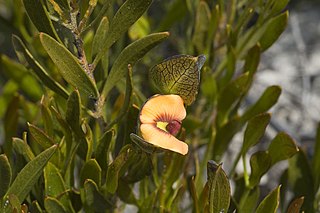
Daviesia alternifolia is a species of flowering plant in the family Fabaceae and is endemic to the south-west of Western Australia. It is a dense, spreading shrub with scattered, egg-shaped phyllodes with the narrower end towards the base, and orange and red flowers with a greenish-yellow centre.
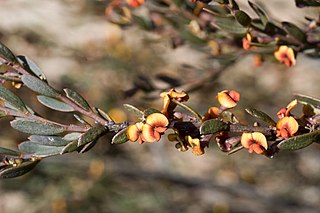
Daviesia argillacea is a species of flowering plant in the family Fabaceae and is endemic to the south-west of Western Australia. It is an erect, bushy shrub with erect narrow egg-shaped phyllodes with the narrower end towards the base, and yellow to orange and maroon flowers.
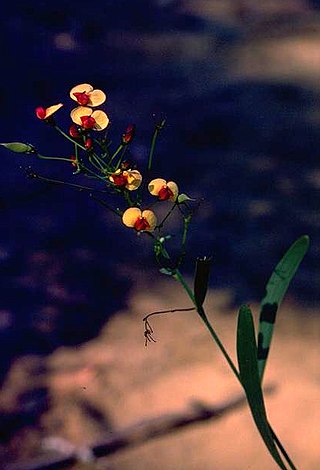
Daviesia costata is a species of flowering plant in the family Fabaceae and is endemic to the south-west of Western Australia. It is a straggling, multi-stemmed shrub with scattered, erect, linear phyllodes, and yellow and dark red flowers.

Daviesia crenulata is a species of flowering plant in the family Fabaceae and is endemic to the south-west of Western Australia. It is a bushy shrub with broadly egg-shaped phyllodes with a sharply-pointed end and wavy edges, and uniformly yellow-orange and maroon flowers.
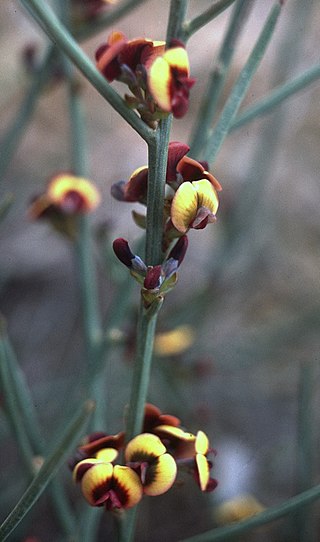
Daviesia debilior is a species of flowering plant in the family Fabaceae and is endemic to the south-west of Western Australia. It is a shrub with low-lying stems and many erect branchlets, scattered linear to scale-like phyllodes, and yellow, purplish, orange-pink and dark purplish flowers.
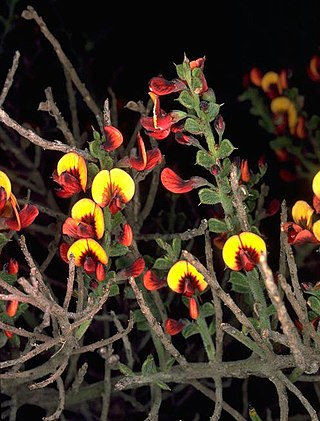
Daviesia dielsii, commonly known as Diels' daviesia, is a species of flowering plant in the family Fabaceae and is endemic to the south-west of Western Australia. It is on intricately-branched shrub with sharply-pointed, egg-shaped, vertically compressed phyllodes, and yellow and red flowers.
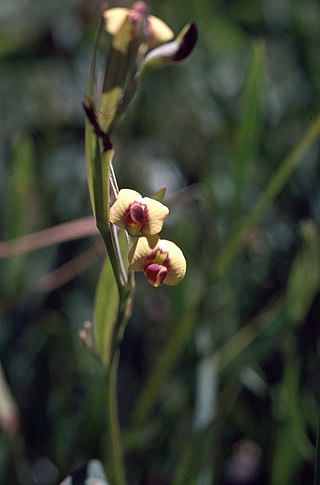
Daviesia elongata is a species of flowering plant in the family Fabaceae and is endemic to the south-west of Western Australia. It is a glabrous, spreading or sprawling shrub with narrowly egg-shaped to linear phyllodes and yellow-orange and maroon flowers.

Daviesia glossosema, commonly known as maroon-flowered daviesia, is a species of flowering plant in the family Fabaceae and is endemic to a restricted area of south-western Western Australia. It is an erect shrub with tangled, spreading branches, cylindrical, sharply-pointed phyllodes, and unusually-shaped maroon flowers.

Daviesia gracilis is a species of flowering plant in the family Fabaceae and is endemic to the south-west of Western Australia. It is an open, spreading shrub with its phyllodes reduced to scales, and has orange-yellow and maroon flowers.

Daviesia incrassata is a species of flowering plant in the family Fabaceae and is endemic to the south-west of Western Australia. It is an erect, mounded to spreading shrub with more or less zigzag branchlets, scattered needle-shaped phyllodes and orange, deep red and pink flowers.
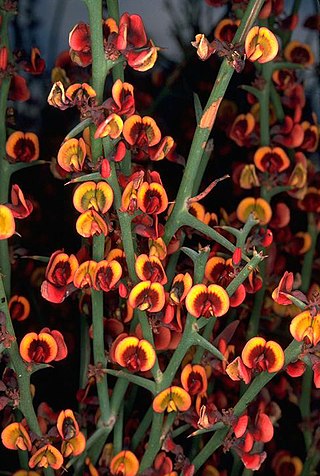
Daviesia intricata is a species of flowering plant in the family Fabaceae and is endemic to the south-west of Western Australia. It is a glabrous shrub with densely tangled branches, sharply-pointed, needle-shaped or flattened phyllodes and apricot-yellow and dark red flowers.

Daviesia megacalyx is a species of flowering plant in the family Fabaceae and is endemic to a restricted part of the south-west of Western Australia. It is an erect, glabrous shrub with scattered, leathery, elliptic phyllodes and apricot-coloured and deep pink flowers.
Daviesia microcarpa, commonly known as Norseman pea, is a species of flowering plant in the family Fabaceae and is endemic to two small areas of inland Western Australia. It is a sprawling shrub with tangled stems and crowded, needle-shaped, sharply-pointed phyllodes, and orange and pinkish-red flowers.

Daviesia microphylla is a species of flowering plant in the family Fabaceae and is endemic to the south-west of Western Australia. It is an openly-branched, sprawling shrub with spiny branchlets, crowded, sharply-pointed, egg-shaped phyllodes, and orange, dark red and maroon flowers.

Daviesia reclinata is a species of flowering plant in the family Fabaceae and is endemic to northern Australia. It is a prostrate or straggling shrub with scattered linear phyllodes, and yellow flowers.
Daviesia scoparia is a species of flowering plant in the family Fabaceae and is endemic to the south-west of Western Australia. It is a broom-like, glabrous, leafless shrub with yellow, dark reddish-brown and maroon flowers.
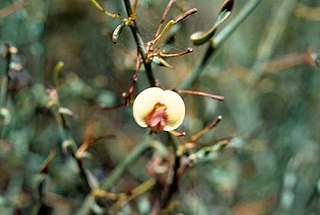
Daviesia spiralis, commonly known as spiral-leaved daviesia, is a species of flowering plant in the family Fabaceae and is endemic to a restricted area of south-western Western Australia. It is a rounded shrub with tangled branches, scattered, twisted linear phyllodes and yellow and red flowers.
Daviesia subulata is a species of flowering plant in the family Fabaceae and is endemic to a restricted area in the south-west of Western Australia. It is a dense shrub with vertically flattened, sharply pointed phyllodes and yellow and red flowers.

















